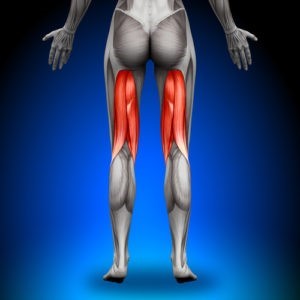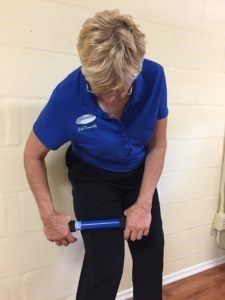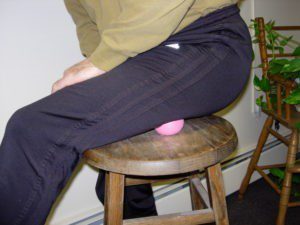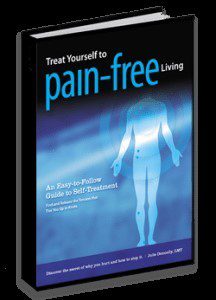Stretching Hamstrings Can Cause Them To Tear
Author: Julie Donnelly, LMT – The Pain Relief Expert
Editor: Dr. Steve Chaney
 “Don’t stretch your hamstrings” is the opposite advice to that given to the vast majority of athletes, especially runners. There is good reason to stop before you stretch, and consider why your hamstrings feel tight in the first place before determining how to treat tight hamstrings.
“Don’t stretch your hamstrings” is the opposite advice to that given to the vast majority of athletes, especially runners. There is good reason to stop before you stretch, and consider why your hamstrings feel tight in the first place before determining how to treat tight hamstrings.
I received a message about a hamstring injury on one of the forums that I moderate. The message came from a father who was concerned about his 12YO son, an avid athlete. While stretching his hamstrings, he heard a “pop” and immediately felt pain at his butt and behind his knee. A few days had passed and the boy was still having hamstring pain while sitting and walking.
The first thing someone may tell him is to stretch, and that’s the last thing that should be done. He needs to get an MRI to make sure that his hamstring tendon isn’t torn. If that’s okay, then he needs to look more in depth to find out why his hamstrings are tight.
Why Your Hamstrings May Be Overstretched
 Very often your hamstrings will feel tight even though they are actually being overstretched! Your hamstrings originate on your posterior pelvis, and one of your quadriceps muscles originates on the front of your pelvis. The quadriceps muscle is Rectus Femoris which goes from your pelvis, over your kneecap and down to your shin bone.
Very often your hamstrings will feel tight even though they are actually being overstretched! Your hamstrings originate on your posterior pelvis, and one of your quadriceps muscles originates on the front of your pelvis. The quadriceps muscle is Rectus Femoris which goes from your pelvis, over your kneecap and down to your shin bone.
When your Rectus Femoris is tight, it will pull your pelvis down in the front. This causes your pelvis to move up in the back, and your hamstrings get overstretched. Your hamstrings feel tight, but if you then try to stretch them, you could tear them. In fact, if they are tight enough, you could actually pull the tendon away from the bone.
I’ve found that your hamstrings will often release on their own when you treat your quadriceps. As your quadriceps aren’t pulling down on the front of your pelvis, it allows your posterior pelvis to go down. As your posterior pelvis goes down, it releases the over-stretch from your hamstrings.
How to Treat Tight Hamstrings
 Pay attention to tight quadriceps when deciding how to treat tight hamstrings.
Pay attention to tight quadriceps when deciding how to treat tight hamstrings.
Fortunately, it’s really easy to release the tension in your quadriceps. I teach these treatments, and many more, in my book: Treat Yourself To Pain-Free Living.
In this picture, I’m using the Julstro Power Roller to push (don’t roll) from the top of my thigh to just above my knee.
I’ve found that the Power Roller gives more focused strength than using a foam roller. Also, tools that have beads that roll can’t go deep enough to reach the lower fibers of this thick muscle.
You’ll find a big spasm, which feels like a bump, at the point shown in this picture. When you go over the spasm, it will hurt so start out slow and build up strength to go deeper.
Also, treating your quadriceps will not only help release your hamstrings, but it is also the treatment for knee pain. This helps you eliminate two painful conditions, not just one! This is also one of the series of treatments for releasing low back, hip, and groin pain. It’s an especially good self-treatment to learn. You can also do this treatment while sitting in a chair with your knee slightly bent.
How to Treat Tight Hamstrings While Treating Spasms
 AFTER you treat your quadriceps, then you can treat your hamstrings. The picture on the left not only treats the spasms, but it also stretches your hamstrings.
AFTER you treat your quadriceps, then you can treat your hamstrings. The picture on the left not only treats the spasms, but it also stretches your hamstrings.
I prefer the Julstro Perfect Ball over any other type of ball. The Perfect Ball is solid in the middle and soft on the outside, giving great pressure without hurting the muscle.
Put the Perfect Ball on a hard surface such as a wooden stool or corner of a desk.
Rest your hamstrings on top of the ball, moving until you find the spasm in the muscle.
Finish by straightening your leg which will stretch your hamstrings. Go slowly and don’t strain the muscle, just move to a “hurts so good” level.
 Treat Yourself to Pain-Free Living shows you how to treat spasms from your head to your feet. If you are in pain, or if you love sports and your joints feel tight, this book will become your favorite “tool!”
Treat Yourself to Pain-Free Living shows you how to treat spasms from your head to your feet. If you are in pain, or if you love sports and your joints feel tight, this book will become your favorite “tool!”
Now, you know how to treat tight hamstrings.
Wishing you well,
Julie Donnelly
About The Author
Julie Donnelly is a Deep Muscle Massage Therapist with 20 years of experience specializing in the treatment of chronic joint pain and sports injuries. She has worked extensively with elite athletes and patients who have been unsuccessful at finding relief through the more conventional therapies.
She has been widely published, both on – and off – line, in magazines, newsletters, and newspapers around the country. She is also often chosen to speak at national conventions, medical schools, and health facilities nationwide.
These statements have not been evaluated by the Food and Drug Administration. This information is not intended to diagnose, treat, cure or prevent any disease.

